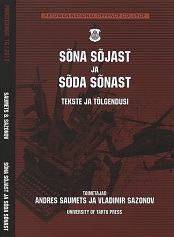Martensi klausli areng ja osised
Development and Elements of the Martens Clause
Author(s): René VärkSubject(s): Law, Constitution, Jurisprudence
Published by: Kaitseväe Ühendatud Õppeasutused
Summary/Abstract: For over a century, the Martens clause has guided and inspired the development and application of the rules of warfare. Law can never foresee every possible situation, and there are inevitably some gaps and inconsistencies. But the lack of clarity does not mean that if something is not explicitly forbidden, it is allowed – there are always certain boundaries. The Martens clause aims to overcome such deficiencies by stressing that until a more complete code of the laws of war is issued, populations and belligerents remain under the protection and empire of the principles of international law, as they result from the usages established between civilized nations, from the laws of humanity and the requirements of the public conscience. This is a useful guide in situations where treaties or customary law are silent or ambiguous, but one must also be cautious because the clause is not an almighty magic wand, and its content and effect are not clear either. What is exactly behind established usages, the laws of humanity and public conscience? The past century has demonstrated that the clause is dynamic and adaptable, and its meaning is determined by the current state of mind of the international community. The clause has been characterised as elusive and enigmatic, escaping any prior uniform understanding. But its worth and usefulness becomes more apparent when applying the clause to specific practical situations. The first element can basically be equated to customary international law, but the other two elements are much more difficult to explain — one has to consider simultaneously the following: human rights, the fundamental values of the international community, public opinion, positions of different inter- and non-governmental organisations, state and court practice, and etc. Then the result is certainly somewhat subjective, but this is inevitable in situations where States have not adopted specific legal regulations. Of course, there is a risk that the clause is appropriated to further a position that has no standing in current international law. All-in-all, the clause recognises something very reasonable and hardly anyone denies that its message is useful and appropriate.
Journal: KVÜÕA toimetised
- Issue Year: 2012
- Issue No: 16
- Page Range: 142-158
- Page Count: 16
- Language: Estonian

